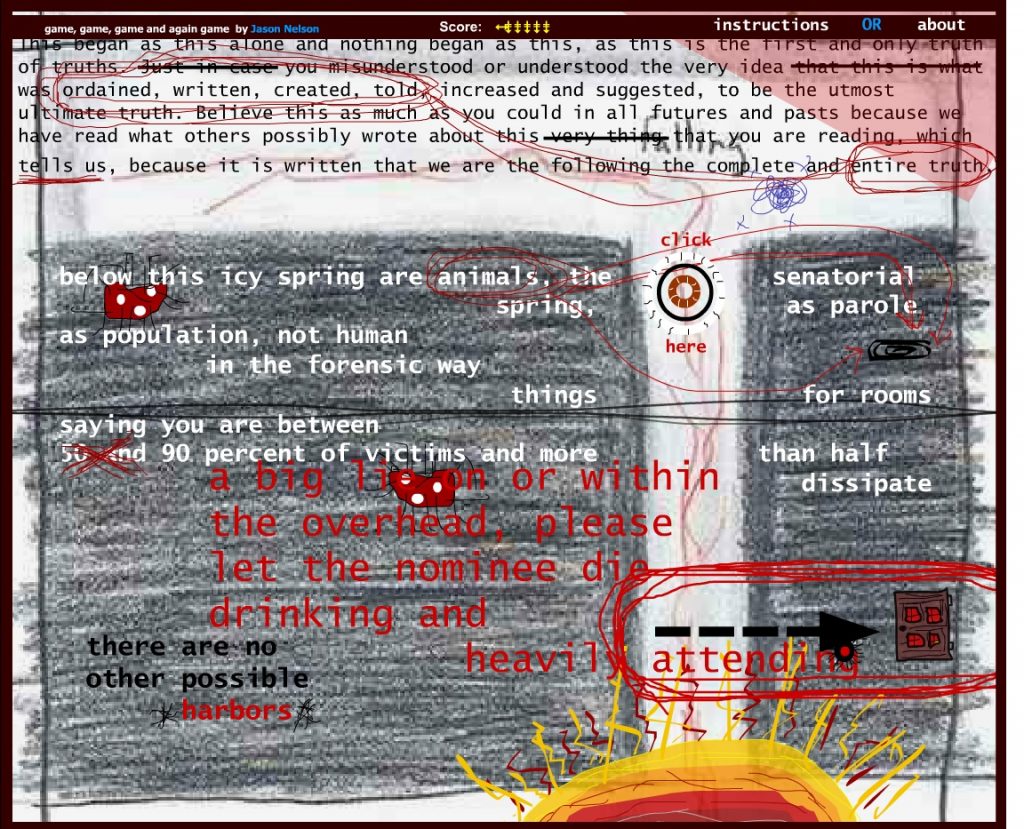As technology progresses, the toolbox of content creators gains ever more tools. As we saw in Grammatron, Hypertext fiction could be integrated with multimedia, sound and video, to enhance and create unique experiences. Distancing itself from the roots of Hypertext fiction, video games as a form of interactive e-literature can offer yet more tools to be utilized; through the mechanics of the game and the way the game interfaces with the interactor, the game experience add another layer of nuance.
In Game, Game, Game and Again Game, the interactor engages would could be considered, at least in a mechanical aspect, a typical platforming game such as the classic Mario Bros. games. However, while the interactor is probably used to the shiny graphics of professional games, they instead find themselves confronted with intentionally raw and handmade graphics. The interactor moves through levels, named after different world views such as “capitalism” or “fundamentalism,” gathering objects and navigating to the door at the end of the level. Whenever an object is collected, a piece of text or an image appears on the growingly cluttered and chaotic screen.

Rather than clicking on links to progress the text as one did in Hypertext, it is instead by navigating the game environment that the experience is pushed forward. Once all objects in a level are collected, an icon appears that allows the interactor to start a video while the finish the level. Sometimes, arrows appear as one interacts with the game, guiding them towards the end of the level. The levels themselves probably won’t be a challenge for anyone who’s played other games in the fashion, and any difficulties arise more frustration in the interactor than feelings of genuine challenge. Between the old home videos, showing sincere moments of humanity, and the snarky cries of “Come on and meet your maker!” at the sometimes frequent incidences of player death, and the scattered bits of text and level titles that hint a larger philosophical design, the interactor is merely left to wonder, what is the point of the experience? Is it a metaphor for life, the struggle for meaning, to understand truth? Is it a game? An interactive art piece? Is there a difference? At the end, when answers would normally be given in a game, the interactor is left with a bizarre, rambling video that begins “In the beginning, there were five potatoes…” but no answers are found.
To contrast, Howling Dogs is a Twine experience that borrows heavily from Hypertext and Choose-Your-Own-Adventures. The game paints a bleak story of a person living a tedious life, surviving on the bare minimum and spending all their time in digital simulations. Dark, atmospheric, poetic, the interactor has a chance to explore a logical space, unlike the abstract thought-space of Game… and of which Grammatron wove in and out. The narrative branches and allows the interactor to experience a story, character, and places rather than concepts, but the experience is almost entirely done through text, fading in and out on the screen as the player clicks through.

The focus on the words ensures that the interactor doesn’t loose valuable information in the chaotic mash of multimedia, putting complete emphasis on the prose of the creator.
In the end, we have two very different examples of e-literature. Game… explores a synthesis of ideas and mediums to find what emerges in interactive gameplay. Howling Dog tightens its usage of media down to text and links to focus the interactor’s experience on the presentation of a cohesive story. Both are examples of different tools content creators can use.